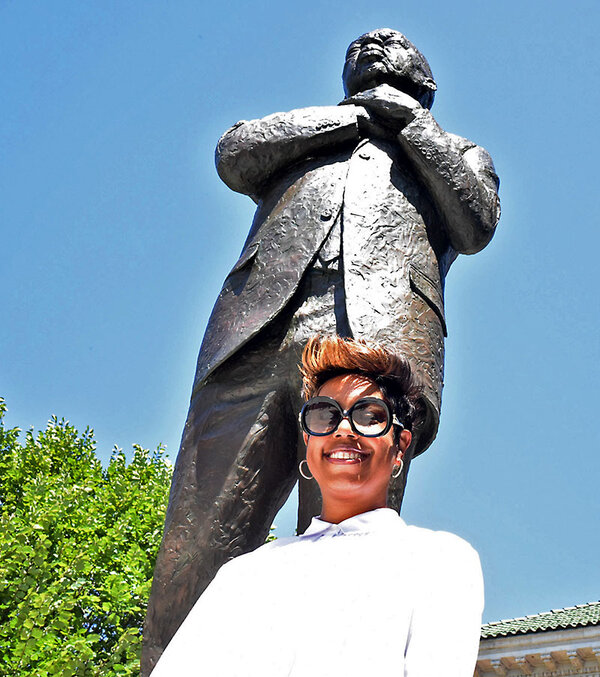Georgia unveiled a statue of John Lewis. It stands on symbolic ground.
Loading...
| Decatur, Ga.
When I learned that a statue of John Lewis would replace a Confederate monument in downtown Decatur, I knew I had to see it, and not just because of my own battles with hate-filled artifacts. In many ways, the late congressman was the personification of the famous hymn “Amazing Grace.” It is fitting that a community would replace something representing a “lost cause” with a dedication to empathy.
“I once was lost, but now am found / Was blind, but now I see.”
The congressman was a mythical figure, even before he posthumously defeated the Confederacy in front of the Historic DeKalb Courthouse. He was one of the bruised heroes of Bloody Sunday. Mr. Lewis suffered a fractured skull when police attacked marchers crossing the Edmund Pettus Bridge from Selma to Montgomery, Alabama, on March 7, 1965. Some 58 people were beaten for peacefully protesting for voting rights. Years before that, Mr. Lewis spoke at the March on Washington alongside Martin Luther King Jr., on behalf of civil rights. Georgia first elected him to Congress in 1986. He would serve until his death in 2020. In later years, the congressman became a comic book hero. His last address was published in one of the newspapers of record.
Why We Wrote This
A story focused onGeorgia unveiled a statue to the late Rep. John Lewis. Where it stands may be just as symbolic as the sculpture of the civil rights icon itself.
The new statue is befitting Mr. Lewis’ legacy. It is larger than life and unmistakably in his likeness. Including the granite pedestal that it sits on, the sculpture is 12 feet tall. It seems like it’s larger, however. Even when standing in a nearby gazebo, onlookers are still not at eye level with the civil rights icon.
How John Lewis’ former staffer thinks about continuing his work
Sunday, the day after the unveiling of the Lewis statue, a Black woman in a white flowing dress takes pictures alongside the sculpture. Her glasses are black-rimmed – taking on the likeness of a Möbius strip, which speaks to a sense of timelessness.
There are also strong emotions behind those frames.
“It was just a very emotional time just to see everyone who was able to gather and pay homage to a man who dedicated his life and his work for building the beloved community,” said Tuere Butler, a former staffer for Representative Lewis who ultimately became his longest-serving employee. “I had the privilege and the honor to serve Congressman Lewis for 22 years.”
For the trained ear, “beloved community” is the tell. It is the language of Kings, of a movement that would change the world. It is a message of hope which endures, even in times where the political and social landscapes are unsure.
“There’s still work to be done. That’s one of the charges that Congressman Lewis left with us. ... There’s still work to be done, and we can’t give up just because it gets challenging or hard, because the community and people are worth it. We’re all in this together,” Mrs. Butler said. “And so, if we’re not willing to roll up our sleeves and fight not only for ourselves, but for our fellow man and woman, what’s the point of us being here on this earth?
“We have to look out for one another and we have to go about this life picking someone up or encouraging someone or pushing them forward so that they can be their best selves,” Mrs. Butler adds. “And in turn, you’re gonna be your best self.”
Even with Mr. Lewis’ likeness and towering presence, however, this statue isn’t just a story about the man who was known for stirring up “good trouble.”
It is decidedly diasporic, thanks to the contributions of Jamaican sculptor Basil Watson, whose description of his approach to art aligns with notions of empathy: “I am inspired by the heroic in mankind, and am moved to express the vitality, beauty, grace and strength of the human figure in its varied shapes, sizes, abilities and functions,” he says on his website. “The spirit that motivates it is limitless in its grandeur.”
When Mrs. Butler took pictures by the statue, the foot traffic nearby was minimal, as if a higher power allowed her space to commune quietly.
Minutes later, a steady wave of onlookers appeared, laughing and taking pictures of their own.
“This man helped us get to where we are today”
Among those passersby were two of Mr. Watson’s compatriots, Sharon Thompson and Rose Douglas. The latter had just recently walked the fated Edmund Pettus Bridge, the site of Bloody Sunday.
“Seeing what’s happening now and knowing that [Mr. Lewis] was trying so hard to unify a country that is so divided,” Ms. Douglas says, “I just wanted to pay respect because we do stand on their shoulders. ... Look around, you can see the diversity right here. This man helped us get to where we are today.”
Ms. Thompson notes that her friend’s previous works include sculptures of Martin Luther King Jr. and Olympic sprinter Usain Bolt.
“[Mr. Watson] represents Jamaica, and the world, really. He’s done so many sculptures, but John Lewis is super special,” she says. “It gives me a sense of pride knowing that my countryman did this.”
But the final word belongs to Malcolm Williams, an Afrofuturistic artist who also journeyed to see the new statue. He found meaning not only in the artwork, but in what it replaced.
“Being an artist, I wanted to see another medium like this, and how it really captured the emotion of someone who really lived and loved what he was doing,” Mr. Williams says. “The more that we uproot seeds of hate, the more that we can allow love to blossom.”







